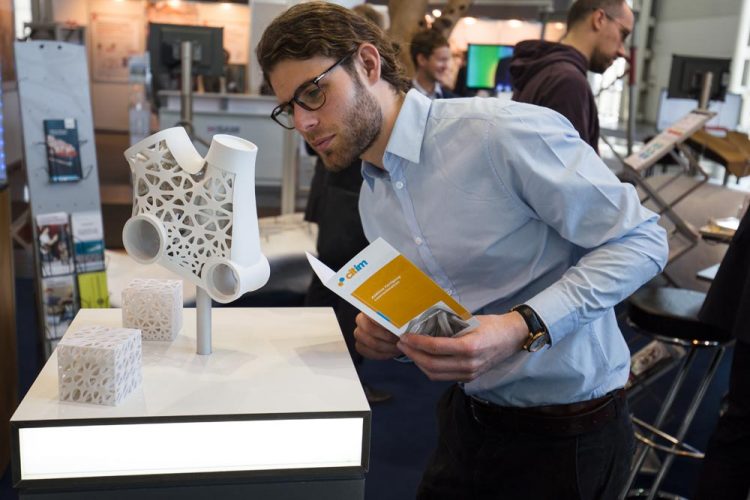Bionic Lightweight Design researchers of the Alfred Wegener Institute at Hannover Messe 2016

Jedes Jahr ist ELiSE Leichtbau auf der Hannovermesse vertreten und überzeugt Kunden aus Industrie und Wirtschaft von den Vorteilen des bionischen Leichtbaus. (Foto: Paul Bomke)
Researchers of the Alfred Wegener Institute (AWI) will introduce their latest developments in the field of bionic lightweight design at Hannover Messe from 25 to 29 April 2016. Their focus is on the ELiSE lightweight construction method, which uses structures from nature to gain a developmental edge over methods that start from scratch.
The industry is currently looking for lightweight reinforcement of complex flat and 3D-components. The AWI researchers have developed and built a holo pyramid that allows them to demonstrate the different procedures to the trade fair visitors.
Life forms that are perfectly adapted to their environment are successful, those with poor adaptation do not survive during the course of evolution. The researchers have embraced this principle: they study the technical principles of animals and plants to derive a lightweight construction principle and to optimise structures.
At the Alfred Wegener Institute, Helmholtz Centre for Polar and Marine Research (AWI) the biologists and engineers working on bionic lightweight constructions have specialised in single-celled sea algae such as diatoms. These phytoplankton organisms fascinate the researchers as they have extremely light yet stable silica shells, which are expressed in a wide variety of complex geometric structures.
“We are currently working on a method that automatically reinforces surfaces with a load-oriented honeycomb geometry,” says Dr Christian Hamm, head of the bionic lightweight construction department at the Alfred Wegener Institute about their current research focus.
The automobile and aviation industry currently has a great demand for such particularly tough, rigid and at the same time lightweight structures. The AWI researchers have already successfully collaborated with partners from diverse industries, such as the automotive industry, the healthcare sector, shipbuilders and manufacturers of offshore constructions.
Here, the AWI bionics researchers focus on their patented development method: ELiSE – Evolutionary Light Structure Engineering. The optimal development of a product passes several stages: First, the structures of the 90,000 samples of the Hustedt Diatom Collection and the internal database are investigated to find diverse lightweight principles with a high potential for a technical adaptation. The modes of action behind the function are abstracted into bionic concepts, analysed using computer models and optimised in several stages.
The components optimized with the ELiSE method can be produced with various materials, such as metal or plastics and using different processes such as 3D print, injection moulding and sheet metal construction. The AWI researchers use, for example, additive manufacturing to produce components with a 3D printer. To give the trade fair visitors a vivid impression of the various possibilities offered by their bionic approach to develop new lightweight solutions, the AWI researchers came up with something very special:
They constructed a holo pyramid that visualises the various processes and bionic reinforcement structures as three-dimensional holograms. They have also brought with them components that they printed in their Lab as well as last year's trade fair exhibit (the folding Bionic Bike developed in a 3D print process) to present the full spectrum of exhibits to the visitors.
Seven members of the bionic lightweight construction team of the Alfred Wegener Institute are looking forward to discuss innovative lightweight solutions at Hannover Messe from 25 to 29 April in hall 2, stand A01.
Notes for Editors:
Your scientific contact person at the Alfred Wegener Institute is Dr Christian Hamm, tel. ++49 471 4831-1832 (e-mail: Christian.Hamm(at)awi.de).
Your contact person in the Dept. of Communications and Media Relations is Dr Folke Mehrtens, tel. ++49 471 4831-2007 (e-mail: Folke.Mehrtens(at)awi.de).
Bionics at AWI: http://www.awi.de/en/science/special-groups/bionics.html
Please find printable images and a video (German language) in the online version of this press release: http://www.awi.de/nc/en/about-us/service/press.html
The Alfred Wegener Institute, Helmholtz Centre for Polar and Marine Research (AWI) conducts research in the Arctic, Antarctic and oceans of the high and mid-latitudes. It coordinates polar research in Germany and provides major infrastructure to the international scientific community, such as the research icebreaker Polarstern and stations in the Arctic and Antarctica. The Alfred Wegener Institute is one of the 18 research centres of the Helmholtz Association, the largest scientific organisation in Germany.
http://elise.de/en/ – ELiSE
Media Contact
All latest news from the category: Trade Fair News
Newest articles

Properties of new materials for microchips
… can now be measured well. Reseachers of Delft University of Technology demonstrated measuring performance properties of ultrathin silicon membranes. Making ever smaller and more powerful chips requires new ultrathin…

Floating solar’s potential
… to support sustainable development by addressing climate, water, and energy goals holistically. A new study published this week in Nature Energy raises the potential for floating solar photovoltaics (FPV)…

Skyrmions move at record speeds
… a step towards the computing of the future. An international research team led by scientists from the CNRS1 has discovered that the magnetic nanobubbles2 known as skyrmions can be…





















